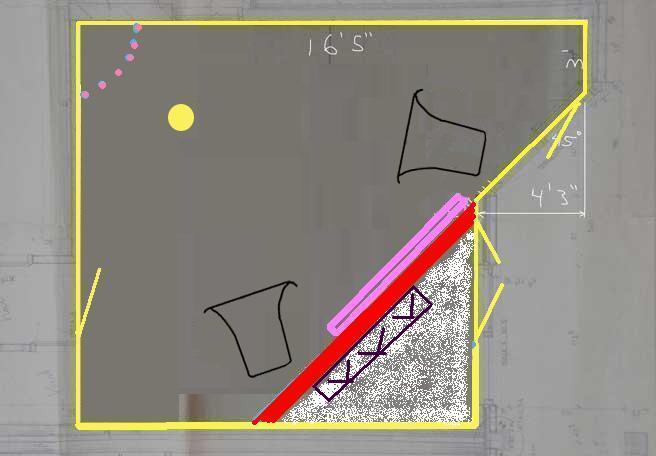Rerurn to Romy the Cat's Site
In the Forum: Playback Listening
In the Thread: Building a new music room
Post Subject: Follow-up on Music Room OptionsPosted by RF at Ona on: 10/20/2007
Collin,
I am pleased that you found my suggestions worthwhile.
I approached the issue of your music room with two questions in mind:
1- How to avoid the structural angle from interfering with the sound
2- Would an enlarged room be worthwhile?
Exploiting the basic rectangular shape of your original room with speaker placement by the long side deals with the first.
Although enlarging the room creates a less desirable square space, one can make virtue of necessity with a diagonal placement along the extended 45-degree angled wall.
The diagonal placement approach works more naturally in a square room since the listener corner is centered. Conversely, diagonal placements are awkward in rectangular rooms because the opposing corner where the listener is placed does not lie between the speakers but off to one side. So by enlarging and squaring your room one gains the option of diagonal placement. Also since part of the room has a structural intrusion, you don't lose all that much space with this approach. I concluded that an enlarged room would be quite worthwhile with this approach.

I basically intended that the angled wall extension behind the speakers would be an architectural wall (heavy red line in the diagram) acoustically separating the small triangular space (white speckle). However I showed how the space could be tested with moveable barriers like shelving, but my original concept and continued recommendation is to eventually make that wall structural. You might possibly reuse the brick and concrete you are removing to enlarge the room in building this extension.
Since your TV is flat and doesn't need space behind, all of the triangular space could be used for something. I would tend to use some of it for an infinite baffle (or very large enclosure) woofer array. Well done, an IB woofer can be a very good approach to reproducing the bottom octave as well as useful for your video sound effects. Why not take advantage of your dedicated music room in this way? Of course you may have other plans that take into account the windows and doors - compromises may be in order.
Regarding your other questions,
a) There is nothing special about the wide hexagon shape. It is symmetrical and so might support good imaging and would have reasonable standing wave characteristics. I simply used it as the kernel of an idea of what kind of useful acoustic space your enlarged room would support and worked from there. Had your room naturally fitted a rectangular or wide octagonal geometry I would have started from one of those basically useful shapes.
b) If a small space is acoustically sealed (isolated) from the main listening room, you don't have to worry about it. But you don't want to partially block a space, as the constrained air in the cavity would be resonant. This phenomenon is the basis for a vented box/bass reflex speaker where, of course, the parameters are adjusted for a useful resonance. Better to leave the space wide open than partially enclosed (partially filled, reducing air volume is OK). Think of the space as filled by ricocheting ping-pong balls. If it tends to trap the balls it is bad, if the balls can escape easily it is better.
You do want to worry about thin panel doors, like closet doors, and windows in the main listening room. I am no acoustic purist in these matters however. I think large windows giving a lovely view are a blessing and as good a reason to pay real property taxes as any. The practicalities of family life and the courtesies of social living also must be observed. I have spent many hours listening with headphones with this in mind.
Finally, let me add a personal point of view. If you walk into a room and you are not really aware of its acoustics - it is probably a good room (good staring point) for an audio system and that should be your basic first goal in furnishing the room. If you sense that it is highly echoic or that it is sounds unnaturally dead from aggressive acoustic treatment or if you have trouble with hearing a normal conversation in it you have more work to do. Although our senses accommodate to the environment, I have never liked long-term listening in a room with a basically unpleasant or contrived acoustic no matter what advantages the acoustical treatments have on the audio system.
Best wishes on your project. May the results exceed the anticipation,
Robert
Rerurn to Romy the Cat's Site